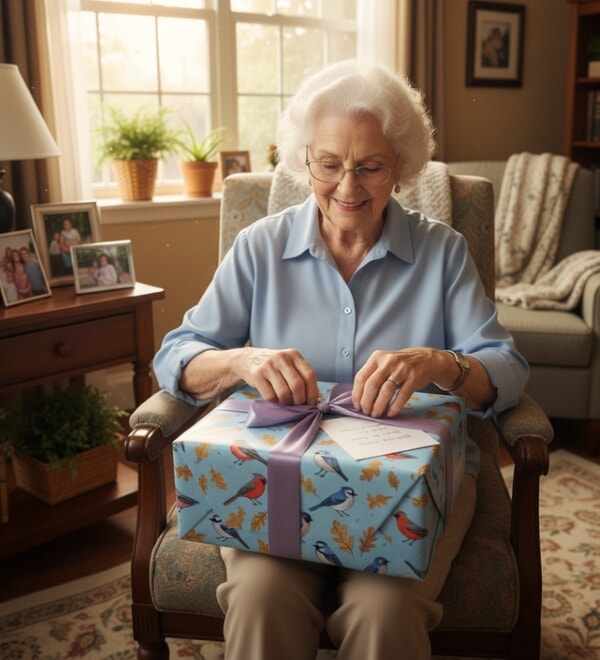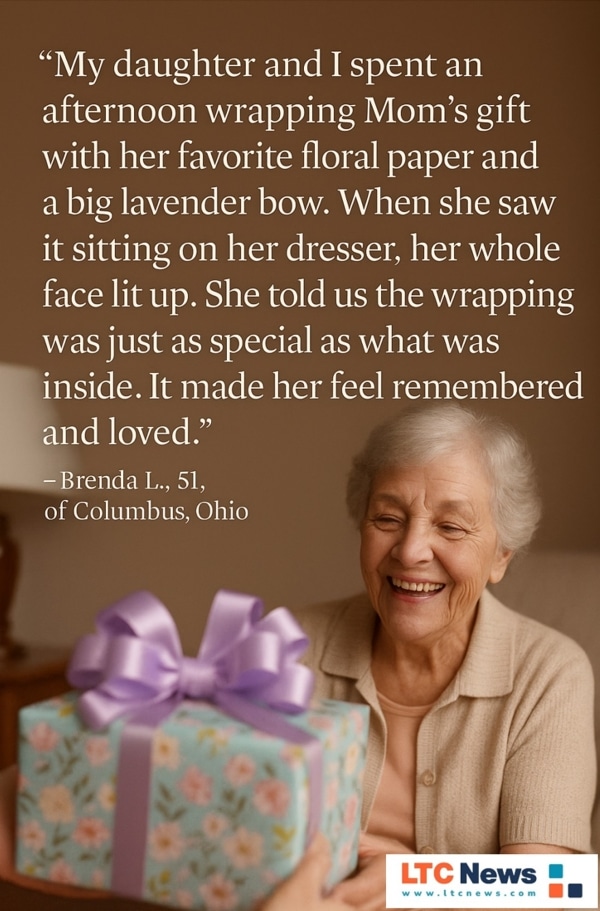Small Gestures, Big Impact: How Personal Touches Boost Emotional Health in Gift Giving for Older Adults

You want your loved one to feel seen, not lost in a routine. A simple note in large type. A favorite color on a ribbon. A photo box that sparks a story. These touches seem small. For an older adult, it can change the day and support their emotional health.
These small touches are especially important for older adults living in long-term care facilities, where they are away from their past surroundings and loved ones. Person-centered care is now the standard in U.S. long-term care. Federal rules place the resident “as the locus of control,” with choices that reflect their life and preferences. Personalization helps you live that standard in everyday moments.
Loneliness and isolation represent profound threats to our health and well-being. But we have the power to respond. — U.S. Surgeon General’s Advisory, 2023.
Why Personalization Matters
Personalization affirms identity. It tells your loved one, “I remember who you are.” That affirmation is not cosmetic. It supports mood, social connection, and quality of life.
Federal guidance on person-centered care emphasizes resident choice and control. Your small choices can reinforce that daily.
Social connection also protects health. National reviews link social isolation to higher risks for heart disease and stroke. The Surgeon General's Office considers social connection a key driver of health throughout the lifespan. Thoughtful, personal gestures help build that connection in care settings.
What The Evidence Says
Personalization works best when it taps memory, senses, and routine. Research in long-term care supports several approaches you can adapt today.
Evidence Snapshot
- Familiar stories and images
- Reminiscence therapy uses photos, objects, and prompts to spark memories and improve well-being in residents with dementia. Multiple reviews and trials support the effectiveness of this type of therapy.
- Personalized music
- Studies in nursing homes have shown that individualized music playlists can reduce agitation and may lower medication use in residents with dementia.
- Purposeful activity
- The National Institute on Aging recommends adapting activities and materials to the person’s abilities and interests to maintain engagement and dignity.
These findings align with person-centered care principles that require a plan tailored to the resident’s goals, preferences, and abilities.
How Presentation Creates a Moment
A gift is more than what sits inside the box. The ritual of receiving, reading, and opening can be the moment itself. For older adults, including those in extended care, that moment can offer stimulation, control, and a sense of joy.
- Build anticipation and joy
- A visible tag in large, high-contrast type with their name invites the resident to engage. Unwrapping becomes an activity, not a task.
- Reinforce dignity
- A neat label with a nickname or a note in your handwriting respects the person’s identity and history. Person-centered care is about choice and self. Your presentation signals both.
- Stimulate memory and senses
- Utilize textures and images associated with past roles and hobbies. Memory boxes, photo envelopes, ticket stubs, or a team logo can unlock conversation. Sensory cues matter in dementia care.
Families often focus on what to give, but how a gift is presented can be just as meaningful. Thoughtful presentation, whether it’s a soft color palette, familiar texture, or a handwritten note, creates emotional architecture that reminds your loved one: You’re seen, valued, and loved.
Wrapping is Key
Personalized wrapping doesn’t need to be elaborate. A simple box tied with ribbon in a favorite color, or paper featuring familiar images, can hold deep significance. These choices communicate more than style—they convey presence, intention, and care.
Experts say that aging adults thrive when their environment reflects familiarity and love.
Home is where we can express ourselves. People who have a match between personality and living space report better well-being, and they feel better about their life and have a better mood. — Karen Fingerman, professor of human development and family sciences at The University of Texas at Austin and director of the Texas Aging and Longevity Center.
The goal isn’t flashiness—it’s connection. For an aging parent, grandparent, or friend, packaging that evokes calm and warmth can transform an ordinary object into a meaningful experience. Each fold of paper, every note written by hand, becomes part of the story.
When selecting materials:
- Focus on comfort: Soft-touch textures and calming colors offer sensory comfort.
- Keep accessibility in mind: Avoid tape-heavy wrapping or complex bows that require dexterity.
- Personalize with purpose: Use names, familiar imagery, or symbols from family history.
- Choose intention over trend: What matters most is emotional familiarity, not aesthetic novelty.
Families don’t need expensive or branded packaging to achieve this effect. What makes the difference is mindfulness—the awareness that design can reflect dignity, evoke memory, and create a sense of belonging.
Brands like Wonder Wraps recognize that packaging is more than decoration, it’s emotional architecture. You should find customizable wrapping and intentional design choices that help turn ordinary gifts into affirming experiences for loved ones in care.
In the structured environment of a long-term care facility, those subtle emotional cues are potent reminders that life is still filled with beauty and connection. If the older loved one is still at home, this will still apply.
As you prepare your next package or note, ask yourself: What would make them smile before they even open it? That thought alone is a gift.
Ask yourself: what color, texture, song, or phrase would feel like “home” to your loved one?

Share your thoughts and experiences about aging, caregiving, health, retirement, and long-term care with LTC News —Contact LTC News.
Practical, Safe Ideas You Can Use Now
Start simple. Keep it easy to open. Think contrast, clarity, and comfort.
- Choose easy-open packaging. Skip tight knots and tape. Use lift-off lids or soft ribbon.
- Write large, high-contrast notes. Black marker on light card. Short sentences. Clear sender name.
- Add familiar visuals. Gardening print for a retired gardener. Tartan ribbon for Scottish heritage. A postcard from a favorite city.
- Include tactile comfort. Soft paper, fabric ribbon, or a small textured sticker for grip.
- Pair with personalized audio. A QR code to a short voice message or a familiar song can cue recognition. Personalized music shows benefits in dementia care.
- Make it routine. Send small, ordinary-day surprises. Predictable connection supports well-being.
Coordinate with staff in the facility about infection-control rules, scented items, shared-room etiquette, and safe object sizes. Ask if the facility has memory boxes or life-story displays you can help fill.
Personalization in Memory Care
Memory care teams often use life-story boards, labeled drawers, and themed memory boxes. Families can strengthen these tools.
- Provide labeled reproductions of family photos.
- Contribute safe objects from work or hobbies.
- Record a brief “About Me” card: preferred name, favorite music, daily comforts.
These approaches reflect the same person-centered planning standards that federal and state regulators use when evaluating evidence of resident choice and engagement.
Accessibility Tips for Low Vision and Dexterity
- Print at 16–18 point or larger.
- Use high contrast (dark text on light background).
- Favor matte over glossy paper to reduce glare.
- Replace twist ties with velcro dots or pull tabs.
- If arthritis is present, choose lightweight boxes and avoid tight lids.
The goal is independence and comfort. You want your loved one to be able to open and enjoy the item without assistance.
Simple Personalization Checklist
- A short, warm note in large print
- One familiar color, pattern, or team
- One safe, tactile element
- An easy-open container
- A photo or small memento they can keep visible
- Optional: a personalized playlist or brief voice message
When Personal Touches Support Caregiving
Personal gestures do not replace care. They make care more human. They also help families feel connected when they are unable to visit. The Surgeon General’s advisory highlights the broad health impact of social connection. Your consistent, personal presence is part of the public health solution.
If a change in mood or behavior occurs after a loved one receives a gift or new object, please notify the staff. Adjust materials if an item becomes confusing or frustrating. Keep what works. Retire what does not.
The Bottom Line
You do not need expensive gifts to make a difference. You need presence. Pick one personal detail. Make it safe and easy. Repeat it often. That is how you help a loved one feel known and valued where they live now.


